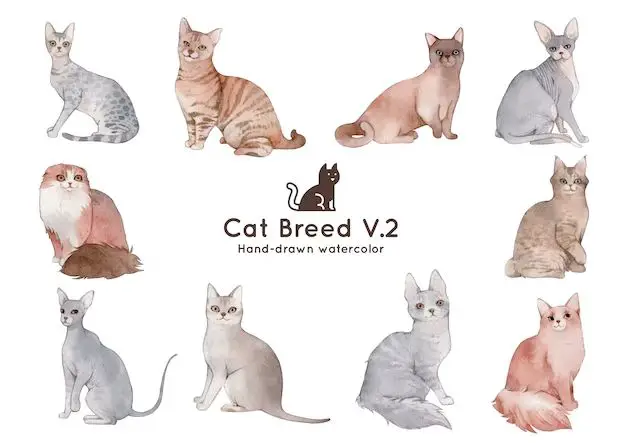Determining the breed of a kitten can be tricky, especially if the kitten is young or mixed breed. However, there are some ways to make an educated guess about your kitten’s ancestry. This article will go over different methods you can use to identify your kitten’s breed.
Look at Physical Features
A kitten’s physical appearance can provide good clues about its breed. Here are some physical features to look for:
- Body type – Stocky vs svelte, proportional limb length
- Coat length – Short, medium, long
- Coat texture – Silky, fluffy, coarse
- Coat color and pattern – Solid, tabby, spotted, bi-color
- Ear shape and placement – Pointed, rounded, set high or low
- Eye color and shape
- Tail shape and length – Plumed, bobbed
- Paw size and shape
- Muscle tone and overall size
For example, a kitten with fluffy fur, round eyes, and a plumed tail may indicate some Persian or Maine Coon ancestry. A compact, muscular kitten with rounded ears and short coat could have some British Shorthair in its family tree.
Think About Coat Colors
Certain coat colors and patterns are strongly associated with particular breeds. These include:
| Coat Color/Pattern | Associated Breeds |
|---|---|
| Chocolate, lilac | Havana Brown, Siamese |
| Colorpoint | Siamese, Ragdoll, Birman |
| Tabby – classic, mackerel | Maine Coon, American Shorthair |
| Tabby – spotted | Ocicat, Egyptian Mau |
| Tuxedo | American Shorthair |
| Tortoiseshell, calico | No specific breeds |
So if your kitten is a chocolate colorpoint, there’s a good chance there is some Siamese or Birman in the family history. A classic brown tabby may indicate Maine Coon or American Shorthair ancestry.
Examine the Face
A kitten’s facial features can also provide clues about its breed background. Look at:
- Head shape – Round, wedge-shaped, triangular
- Ear placement – How high/low and widely spaced they are
- Eye shape – Round, almond, oval
- Nose and muzzle shape
- Profile – Flat, straight, or Roman-nosed
For instance, a kitten with a wedge-shaped head, pointed ears, and almond eyes probably has some Siamese in its lineage. One with a round head, round eyes, and rounded ears may have Persian or British Shorthair ancestry.
Observe Behavior
Breed can also influence personality and behavior. Here are some behavioral clues to look for:
| Traits | Associated Breeds |
|---|---|
| Extremely active and playful | Abyssinian, Bengal, Maine Coon |
| Laidback and easygoing | Persian, Ragdoll |
| Loves heights and perching | Siamese, Burmese |
| Fearless and confident | Bengal, Siamese |
| Chatty vocalizations | Siamese, Maine Coon |
| Enjoys water | Turkish Van |
So if your kitten is very talkative and energetic, there could be some Siamese or Maine Coon in its background. A kitten that is quiet and loves sitting in laps may have some Persian in its mix.
Get a Vet’s Opinion
Your veterinarian may be able to help determine your kitten’s breed, especially if they are familiar with different cat breeds. Make sure to bring your kitten in for regular wellness checkups anyway so your vet can examine its growth and development. Some distinguishing breed characteristics are difficult to see in very young kittens but become more pronounced as they mature. Your vet can provide their best guess on possible breeds as your kitten grows.
Try a DNA Test
For the most definitive answer, you can have your kitten’s DNA tested. There are several cat DNA testing kits available from companies like Basepaws, Wisdom Panel, and MyCatDNA. These kits check for genetic markers associated with different breeds. To perform the test, you simply collect a DNA sample from your kitten’s cheek using a swab and mail it to the company’s lab.
Within a few weeks, you’ll receive a report detailing any purebred ancestors detected in your kitten’s lineage over the past 3 generations. Some tests even screen for genetic health risks like hypertrophic cardiomyopathy. DNA tests typically cost $60-150.
Check Ancestry Papers
If you adopted your kitten from a shelter or breeder, see if any ancestry documentation is available. Reputable breeders will often provide registration papers showing a kitten’s purebred parents. Some shelters can provide guesswork on a kitten’s possible breed mix based on its available history.
Do Your Own Research
Spend time browsing pictures and profiles of different cat breeds online. Learn their distinguishing characteristics.Sites like Vetstreet have convenient cat breed guides. The more familiar you become with breed traits, the easier it will be to make an educated guess about your kitten’s heritage based on their looks and personality.
Be Patient
Determining breed ancestry in kittens is not an exact science. Mixed breed cats can display an unpredictable combination of traits. Even purebred kittens can go through awkward growth phases making their breed hard to discern. Don’t be frustrated if you cannot pinpoint your kitten’s origins right away. Let your kitten’s features and personality emerge over time. Their breed ancestry will often become clearer as they mature.
Enjoy Your Unique Kitten
While breed can say a lot about a kitten, what really matters is having a happy, healthy, and loving cat. Shower your kitten with affection and proper care, no matter their genetic background. With time, you will have a wonderful companion cat with their own unique personality and quirks to adore.
Conclusion
Identifying your kitten’s breed requires examining their physical characteristics, personality traits, ancestry documentation, and using resources like DNA tests. But mixed breeds can have unpredictable combinations of features that make identification challenging. With patience, your kitten’s breed ancestry will typically become more apparent as they grow up. Most importantly, ensure your kitten gets the nutrition, vet care, training, affection and stimulation they need to thrive, regardless of their origins.


